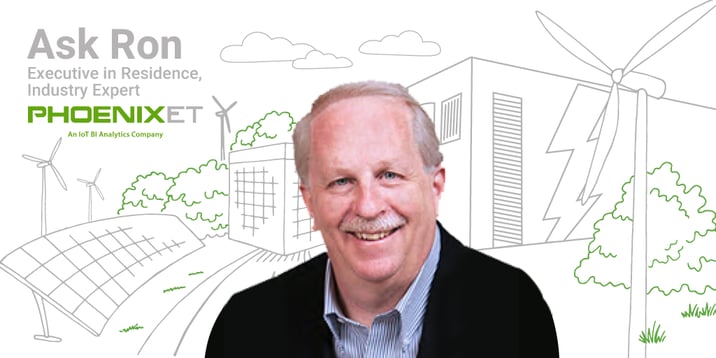Share this
Motors and Building Management: What Energy Managers Need to Know
by Ron Rau on Jun 1, 2020

Your building is full of motors. Almost any climate control system in your building is essentially a motor attached to a pump. If you have RTUs, there’s a motor in there. If you have an AHU, there’s also a motor in there. Refrigeration racks? Better believe there’s a motor in there. Centrifugal chillers? They’ve got a big honkin’ motor.
What’s more, the design of the basic AC induction motor hasn’t really changed since it was invented in the late 1800s. Although they’ve become more efficient, performing more work with the same amount of power, electric motors are still responsible for over 40 percent of global energy use. Assuming that designs aren’t going to get a lot more efficient in the near future, the best thing that facility and energy managers can do to bring down costs is to use motors more intelligently.
It’s All About the Starters
The main barrier between facility managers and more efficient operations is the motors that drive much of their building equipment – and not even the entire motor at that. Instead, the main obstacle to motor efficiency – and therefore, building efficiency – is the starter.
Traditional AC motors in use before the 1990’s were equipped with across-the-line full voltage, non-reversing magnetic starters. This is a lot of jargon, but it boils down to two things:
- As soon as the motor turns, the starter gives it all the current that it’s rated for in a single jolt. This is usually much more than it needs to sustain its workload.
- Once started in this way, the motor runs at top speed and can’t be slowed down – regardless of the job it’s doing.
While traditional AC motors are workhorses and can be found everywhere, this starter has severe disadvantages in terms of both efficiency and controllability. More advanced starters have since been designed. These may include:
- Part-winding starters: which are designed to start the motor without excess current
- Two-speed starters: which can throttle to some extent when used in conjunction with a two-speed electric motor
- Variable frequency drives (VFDs): With a VFD, building systems can start a motor without using too much current, and they can subsequently throttle it from 100% output to almost zero depending on the workload.
Lastly, some manufacturers are discarding the idea of an AC motor entirely and have switched to advanced DC motor concepts. Electronically commutated motors (ECMs) can provide even greater efficiencies in terms of power to output by converting AC current into DC power.
Why Haven’t You Upgraded Your Motors?
With so much new technology available, it seems like buildings should be well on their way to becoming more efficient. Unfortunately, this sometimes isn’t the case. Newer systems may have ECMs or VFDs built-in, but capital equipment such as commercial HVAC systems can last for up to 20 years, which means that they’re likely to be running older part-winding or two-part starters. Some facilities may also be running outdated climate control systems with across-the-line starters as well.
Facility owners and energy managers hoping to upgrade their existing motors may face an uphill battle, as 75 percent of proposed building upgrades are eventually shot down. Fortunately, however, there are compelling reasons why performing a facility-wide motor upgrade.
First, increasingly stringent energy efficiency standards have begun to mandate upgrades such as VFDs. In 2013, for example, ASHRAE 90.1 began mandating that all volume area fans with at or above five hp needed to use a VFD or a similar method of improving energy use. If you want your building to be compliant, VFDs are the law.
Second, converting to VFDs or other energy-saving devices is a relatively inexpensive upgrade that can pay for itself quickly. With the possibility of saving up to 30 percent on total energy costs over the lifetime of the motor, a VFD can pay for itself in as little as one year.
Use Energy Smarter with PhoenixET
Your job isn’t done once you have the VFDs or ECMs. You need to throttle back on motor usage intelligently – using a minimum of power while still keeping building occupants, perishable goods, and mission-critical systems at an appropriate temperature.
Here at PhoenixET, we can help you do that. Our smart building platform is designed to instrument your capital equipment, optimizing its performance without neglecting your tenants. Without using new hardware or switching your existing building management system, we can help you decrease your energy expenses!
For more information, contact PhoenixET today!
Additional Resources
4 Common Myths of Energy Conservation in Building Management
Building Management Technologies Guide
Are You Managing Your Energy Spend?
Share this
- Facilities Management (90)
- Energy Management (69)
- Company News (49)
- Smart Buildings (37)
- Retail (36)
- Building Management (24)
- Building Automation Systems (21)
- Energy Demand Management (19)
- Sustainability (19)
- EEI (15)
- Adaptive Energy Management (14)
- Grocery (14)
- demand response (14)
- Artificial Intelligence (12)
- Data Integration and Visibility (10)
- HVAC IQ (9)
- COVID-19 (8)
- Customer Spotlight (8)
- Carbon Management (7)
- Setpoints and Temperatures (7)
- Equipment Maintenance (6)
- Operational Efficiency (6)
- Ask Ron (5)
- Asset Manager (5)
- Finance and Procurement (5)
- IoT and Digital Transformation (5)
- Refrigeration Optimization (5)
- Awards (4)
- Comfort (4)
- Energy & Store Development (4)
- Safety and Compliance (4)
- Demand Charge Management (3)
- Energy Management System (3)
- Premium Services (3)
- Automated Demand Response (2)
- ConnexFM (2)
- Customer Service (2)
- HVAC Vendor Management (2)
- Lifecycle Asset Management (2)
- Load Shedding (2)
- Refrigeration IQ (2)
- Technician View (2)
- Analytics (1)
- Data (1)
- Data Integration and Visualization (1)
- EMS (1)
- Knowledge Center (1)
- OSHA (1)
- asset management (1)
- November 2025 (1)
- October 2025 (2)
- September 2025 (1)
- August 2025 (3)
- July 2025 (1)
- June 2025 (1)
- May 2025 (2)
- March 2025 (2)
- February 2025 (1)
- January 2025 (2)
- December 2024 (2)
- October 2024 (1)
- September 2024 (1)
- August 2024 (2)
- June 2024 (2)
- April 2024 (2)
- March 2024 (2)
- January 2024 (1)
- December 2023 (1)
- October 2023 (2)
- September 2023 (2)
- August 2023 (2)
- July 2023 (1)
- May 2023 (2)
- April 2023 (2)
- March 2023 (3)
- February 2023 (1)
- January 2023 (1)
- December 2022 (1)
- November 2022 (2)
- October 2022 (2)
- September 2022 (1)
- May 2022 (2)
- April 2022 (1)
- March 2022 (3)
- February 2022 (2)
- January 2022 (4)
- December 2021 (2)
- November 2021 (3)
- October 2021 (1)
- September 2021 (3)
- August 2021 (4)
- July 2021 (1)
- June 2021 (2)
- May 2021 (1)
- January 2021 (2)
- December 2020 (2)
- November 2020 (2)
- October 2020 (3)
- September 2020 (4)
- August 2020 (3)
- July 2020 (2)
- June 2020 (3)
- May 2020 (3)
- April 2020 (5)
- March 2020 (5)
- February 2020 (4)
- January 2020 (4)
- December 2019 (4)
- November 2019 (3)
- October 2019 (4)
- September 2019 (5)
- August 2019 (4)
- July 2019 (4)
- May 2019 (2)
- April 2019 (3)
- February 2019 (1)
- December 2018 (1)
- November 2018 (1)
- October 2018 (3)
- September 2018 (3)
- August 2018 (3)
- July 2018 (3)
- June 2018 (3)
- May 2018 (1)
- June 2015 (1)
- March 2013 (1)
- January 2013 (1)
- December 2011 (1)
- October 2011 (1)
- September 2011 (1)


